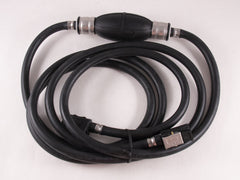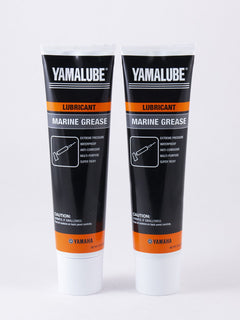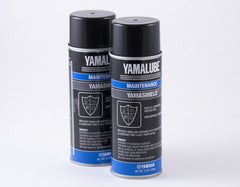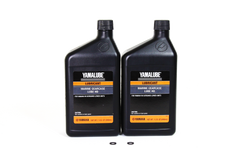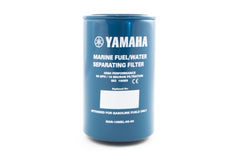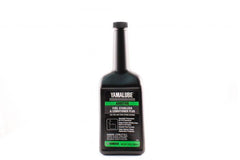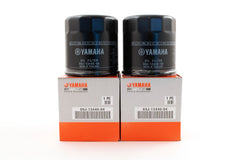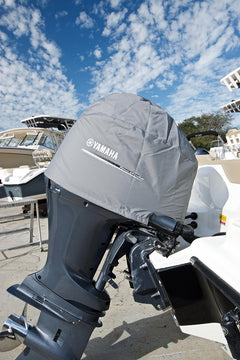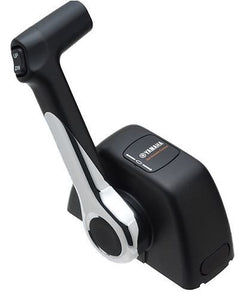Service Intervals for Yamaha Lower Units
Yamaha outboard maintenance is usually broken up into regularly-occurring service intervals based on your usage. These include:
Here’s the good news: Yamaha’s break-in guidelines aren’t overly complicated. With a bit of patience and light throttle work, you’ll help your engine settle in for years of reliable performance.
Initial Break-In Period
Breaking in a Yamaha outboard motor is an important step in ensuring your motor's long-term performance and durability. The break-in process helps to prevent excessive wear and damage to the lower unit, which can be caused by running the engine at high speeds and under heavy loads before the components are properly seated and lubricated.
How to Break-In Your Yamaha Engine & Lower Unit
The break-in process involves gradually increasing the engine's speed and load over the first few hours of operation. Here are the general steps to break in a Yamaha outboard motor:
-
Start the motor and run it at idle speed for several minutes, allowing the engine to warm up.
-
Slowly increase the speed to 2/3 of the maximum rated RPM for the first hour of operation.
-
Gradually increase the speed to 3/4 of the maximum rated RPM for the next two hours.
-
For the remaining hours of the break-in period, gradually increase the speed to the maximum rated RPM and frequently vary the speed and load on the engine.
During the break-in period, it's important to avoid operating the engine at full throttle or under heavy loads, as this can put excessive wear on the engine components and the lower unit. The goal is to allow the engine to wear in gradually and properly seat the piston rings and other components.
Note: If purchasing a refurbished lower unit or engine, follow the steps above to break in the outboard. Some refurbishers handle this process to avoid potential customer issues (especially if the parts are under a new warranty); boaters may have to perform this task themselves or have their engine serviced by a marine mechanic.
After Each Use
Performing maintenance on your Yamaha outboard lower unit after each use is an important step in keeping your motor running smoothly and preventing damage from saltwater corrosion. Here are some maintenance tasks you should perform immediately after each use:
-
Rinse with fresh water: Rinse the entire lower unit and other metal components, such as the propeller and steering components, with fresh water. This will help remove any salt, sand, or other debris that may have accumulated during use.
-
Inspect for damage: Check the lower unit for any signs of damage, such as cracks or dents. If you notice any damage, address it promptly to prevent further damage and potential safety hazards.
-
Check the propeller: Inspect the propeller for any signs of damage or wear, such as dings or chips. If you notice any issues, have the propeller repaired or replaced as necessary.
-
Check the anodes: Inspect the anodes (also known as sacrificial zincs) for signs of wear or corrosion. If the anodes are more than 50% depleted, they should be replaced to ensure continued protection against corrosion.
-
Lubricate moving parts: Lubricate moving parts, such as the propeller shaft, with marine-grade lubricant. This will help protect against corrosion and reduce wear.
-
Drain the lower unit: Drain any water that may have entered the lower unit during use. This is particularly important if you operate your boat in saltwater.
-
Apply anti-corrosion products: Apply an anti-corrosion product, such as Yamashield Rust & Corrosion Protectant, to the lower unit and other metal components. This will help protect against saltwater corrosion.
By performing these maintenance tasks immediately after each use, you can help keep your Yamaha outboard lower unit in good condition and extend the life of your motor. Refer to your owner's manual for specific maintenance recommendations, and consult with a qualified marine mechanic if you have any questions or concerns.
20-Hour Service
A 20-hour service interval for a Yamaha outboard motor typically involves a combination of inspections, lubrication, and replacement of specific components as needed, to ensure that the motor is running smoothly and reliably.
The specific maintenance tasks involved in a 20-hour service interval for a Yamaha outboard motor may vary slightly depending on the particular model and year of the motor but generally include the following:
-
Changing the engine oil: At the 20-hour mark, it's recommended to change the engine oil and oil filter to ensure that the engine is properly lubricated.
-
Inspecting the propeller: Check the propeller for any signs of damage or wear, and make sure it is tightened securely on the propeller shaft.
-
Inspecting the fuel system: Check the fuel hoses, connections, and filters for any signs of damage or wear, and make sure they are properly tightened.
-
Checking the water pump: Inspect the water pump impeller for any signs of wear or damage, and replace it if necessary. Check the water pump housing and inlet screens for any debris or damage, and make sure they are clear and functioning properly.
-
Inspecting the electrical system: Check the battery, wiring, and connections for any signs of damage or corrosion, and make sure they are clean and properly secured.
-
Lubricating moving parts: Lubricate any moving parts, such as throttle and shift linkages, steering components, and other key parts, as needed.
-
Checking and adjusting the idle speed: Check and adjust the idle speed as needed to ensure smooth operation.
100-Hour Service / Annual Maintenance
Similar to the 20-hour service with a few additional tasks, the maintenance tasks involved in a 100-hour service interval (or annual maintenance) for a Yamaha outboard motor may vary depending on the specific model and year of the motor but generally include the following:
-
Replace gear lube: Depending on your usage, the Yamaha lower unit gear oil should be extracted and changed at the 100-hour or one-year mark, whichever comes first.
-
Changing the engine oil and filter: The engine oil and filter should be changed at least every 100 hours of operation or once per year, whichever comes first.
-
Replacing the fuel filter: Replace the fuel filter to ensure that the fuel system is free of debris and functioning properly.
-
Inspecting the spark plugs: Check the spark plugs for signs of wear or fouling, and replace them if necessary.
-
Checking the battery: Inspect the battery and terminals for any signs of damage or corrosion, and make sure they are clean and properly secured.
-
Inspecting the cooling system: Check the cooling system for any signs of damage or wear, and make sure the thermostat is functioning correctly.
-
Inspecting the propeller: Check the propeller for any signs of damage or wear, and make sure it is tightened securely on the propeller shaft.
-
Inspecting the steering system: Check the steering system for any signs of damage or wear, and make sure it is functioning properly.
-
Checking the timing belt: If your motor has a timing belt, inspect it for signs of wear or cracking, and replace it if necessary.
-
Lubricating moving parts: Lubricate any moving parts, such as throttle and shift linkages, steering components, and other key parts, as needed.
Winterizing Your Yamaha Outboard Lower Unit
Winterizing your Yamaha outboard lower unit is an important step in preparing your boat for the colder months and protecting it from the effects of freezing temperatures and moisture.
Here are some of the key steps involved in winterizing your Yamaha outboard lower unit:
Change the gear oil
Start by draining the gear oil from the lower unit and replacing it with fresh, high-quality gear oil suitable for use in cold temperatures. This helps to prevent moisture buildup and corrosion inside the lower unit.
Many boat owners learn the hard way when they pull their boat out in spring only to find the prop shaft corroded solid. Without changing the oil before storage, water and debris can settle into the gearcase—leading to expensive damage that a $15 gear lube kit would have prevented.
Check the seals
Inspect the seals on the lower unit to ensure they are in good condition and not cracked or damaged. Replace any seals that show signs of wear or damage to prevent water from entering the lower unit.
Grease the bearings
Use marine-grade grease (Yamalube Multi-Purpose Marine Grease Lubricant) to lubricate the bearings inside the lower unit. This helps to protect them from moisture and prevent rust and corrosion.
Flush the lower unit
Use a flushing attachment to flush the lower unit with fresh water and remove any salt, dirt, or other debris that may have accumulated. This helps to prevent corrosion and other damage.
Store the boat properly
Finally, store your boat in a dry, sheltered area for the winter months. Cover the boat to protect it from the elements and prevent moisture buildup.
Season Breakout
To properly prepare your Yamaha outboard motor for hours of reliable use, you should follow these steps for a season break out:
-
Flush the engine with fresh water to remove salt or dirt accumulated in the cooling system.
-
Change the engine oil and filter to remove any contaminants accumulated over the season.
-
Drain and refill the lower unit oil to remove any water or contaminants that may have accumulated.
-
Inspect the lower unit for any signs of damage, wear, or leaks. Repair any issues found before storing the motor.
-
Grease the propeller shaft and threads, and the propeller shaft splines.
-
Remove the propeller and check for any damage or debris that may have become lodged in the propeller hub.
-
Apply a thin coat of waterproof grease to the propeller shaft and splines to prevent corrosion.
-
Check and adjust the tension on the drive belts.
-
Clean the exterior of the motor, including the lower unit, with soap and water, and dry it completely.
-
Coat any exposed metal surfaces with a corrosion inhibitor.
-
Remove the battery from the boat and store it in a cool, dry place, or use a battery maintainer to keep the battery charged during storage.
Cover the motor and the boat with a waterproof cover to keep it clean and dry during storage.

